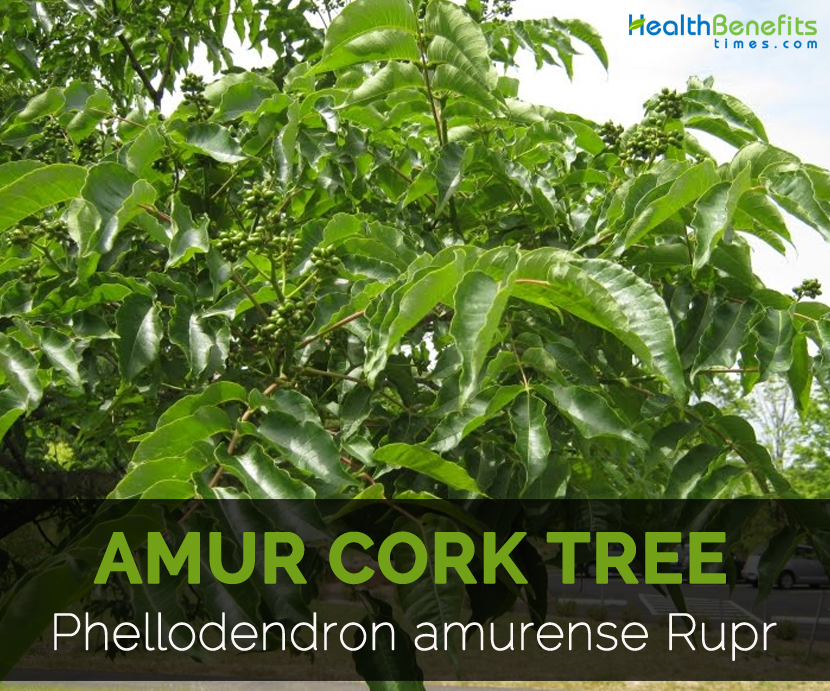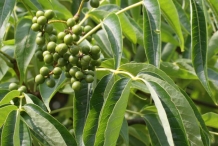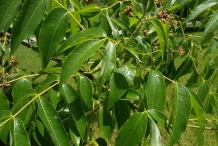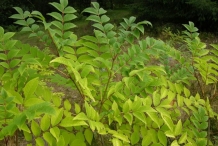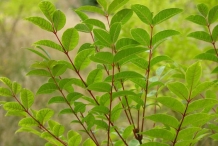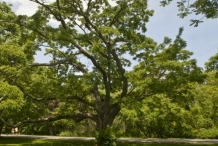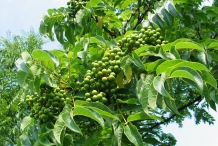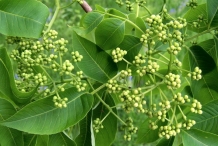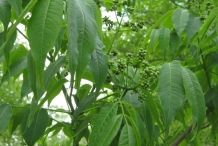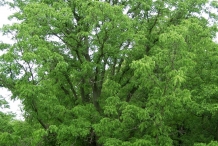History
Inherent to Eastern Asia that includes Japan, Korea, Northern China (Ussuri, Manchuria, Amur). It got introduced for ornamental purposes in United States in 1856. It has been intrusive in Maryland, Illinois, New York, Virginia and Pennsylvania.
This tree got introduced around 1856 in U.D. Firstly the sachalinense variety was acquired by Havard University Arnold Arboretum in 1901 and in 1906, the true amurense. In 1933, it was reported by New York Botanical Garden to be naturalized in forests where it is found today. The bark is used in China, Japan and India for traditional medicines. In ancient China, the inner yellow bark is used to make special dye and yellow paper for the religious and governmental documents. It is used as street tree or ornamental purposes so its demand is increasing as shown by the study in Ohio of urban foresters. The wood is used for manufacturing railings as well as bollards for the erosion control.
Health Benefits of Amur Cork Tree
This herb is used for treating bacillary dysentery, cerebrospinal meningitis, tuberculosis, pneumonia, chronic hepatitis, liver cirrhosis, acute conjunctivitis, trichomoniasis vaginitis, cervical spondylosis, chronic suppurative otitis media and ear eczema.
- Lowers chances of prostate cancer
The study shows that the diet based on plants lowers the chances of prostate cancer. The effect of Nexrutine was examined which an herbal extract is made from Phellodendron amurense which is traditionally used in Chinese medicine for about hundred years for its astringent, anti-diarrheal and anti-inflammatory properties. It inhibits the proliferation of tumor cells by induction of apoptosis and also inhibits the signaling of cell survival. The results shows that the treatment of Nexrutine inhibit proliferation of androgen independent and androgen responsive human prostate cancer cells with apoptosis induction. (1)
- Treatment for osteoporosis
Phellodendron amursense, Cinnamomum cassia and Astragalus membranaceus was used traditionally for the treatment of inflammatory diseases and osteoporosis. It raised the mineral density of bones and prevents decrease of trabecular bone volume, trabecular number, connectivity density, thickness, trabecular number and separation at femur neck and total femur. The serum levels of phosphorus and calcium was decreased in OVX rats and increase in low density lipoprotein, cholesterol, osteocalcin, phosphatase, bone morphogenetic protein-2 and C-telopeptide type 1 collagen. The results shows that BHH10 has the ability to reverse osteoporosis in OVX rats as it stimulates the formation of bones and regulates bone resorption and as it is not related with toxicity. (2)
- Memory dysfunction
The study in the improvement of memory defects caused due to administering scopolamine with the use of Phellodendron amurense and berberine. The effects of BER and PA were found on pro-inflammatory cytokines and acetylcholinergic system. The male rats were provided a daily dose of 100 or 200 mg /kg of PA for 14 days and BER of 20 mg/kg 30 minutes before scopolamine injection. It improved impairment of memory. It alleviated cholinergic immunoreactivity and also restored brain derived neurotrophic factor. It has neuroprotective effects on memory dysfunction and neuronal impairment. It stimulates cholinergic enzyme activity and alleviates inflammatory responses that helsp to improve cognitive functioning. (3)
- Lowers anxiety and stress
The medicinal plants such as Phellodendron and Magnolia are used as traditional remedies for lowering anxiety and stress. The modern dietary supplements promote relaxation and promote stress and also stress related eating. The studies show that is combination lowers perception of anxiety as well as stress and cortisol exposure that improves weight loss. (4)
Traditional uses
- The remedy made from bark acts as a detoxicant.
- It is used to treat conjunctivitis and meningitis.
- Its internal use helps to treat dysentery, acute diarrhea, vaginal infections, jaundice, enteritis, urinary tract infections, abscesses, boils, skin diseases and night sweats.
- The preparation named “injection of three yellow herbs” is made with Coptis chinensis and Scutellaria baicalensis that is useful for upper respiratory tract infections.
- Ainu people use this plant as a pain killer.
- It is used as a treatment for pneumonia, bacillary dysentery, meningitis, liver cirrhosis and tuberculosis.
- The oil is used to treat pancreatitis, lowers cholesterol and sugar in blood and also treats skin ailments.
- Traditionally, it is used to reduce fever.
- The fruit is helpful for treating the cold symptoms.
- Externally it is used to treat eczema around ears.
- It is an aid for meningitis and used as an eyewash for conjunctivitis.
- It lowers fever, blood pressure, blood sugar level and also treat kidney and urine problems.
Precautions
- Pregnant women should not use it.
- Not to be used by the people with weak or cold stomach and spleen conditions.
- Use with professional advice.
Other Facts
Due to illegal and excessive harvesting, the population has declined.
Amur Cork Tree facts
Amur Cork tree is the tree of medium sized having a corky bark and is pest free. It is a deciduous tree that has gray outer bark having thick cork layer with its longitudinal fissure surface and bright yellow under bark. The massive branches spread widely. The branchlets are mostly brown to light brown but rarely found red to orange. It has small and indistinctive flowers which could be either female or male. It has unisexual flowers that are small and dioecious. It is native to Asia and was introduced for its ornamental qualities.
| Amur Cork Tree Quick Facts | |
|---|---|
| Name: | Amur Cork Tree |
| Scientific Name: | Phellodendron amurense Rupr |
| Origin | Inherent to Eastern Asia that includes Japan, Korea, Northern China (Ussuri, Manchuria, Amur). It got introduced for ornamental purposes in United States in 1856. |
| Colors | Green, Black |
| Shapes | Green, Black |
| Health benefits | Lowers chances of prostate cancer, Treatment for osteoporosis, Memory dysfunction, Lowers anxiety and stress |
| Name | Amur Cork Tree |
|---|---|
| Scientific Name | Phellodendron amurense Rupr |
| Native | Inherent to Eastern Asia that includes Japan, Korea, Northern China (Ussuri, Manchuria, Amur). It got introduced for ornamental purposes in United States in 1856. It has been intrusive in Maryland, Illinois, New York, Virginia and Pennsylvania. |
| Common/English Name | Chinese corktree, phellodendron, phellodendron-bark, phellodendron, Amur corktree, Huang Bai, cortex Phellodendri, nark of Chinese corktree, phellodendron bark, cortex phellodendri Chinensis, Amur corktree bark, Amur cork bark, Japanese corktree |
| Name in Other Languages | Swedish: japanskt korkträd, sachalinkorkträd, sibiriskt korkträd; French: phellodendron de l’Amour, arbre liège de Chine, arbre à liège de l’Amour, phellodendre de l’Amour, phellodendron de Sibérie Japanese Rōmaji: kihada; Transcribed Korean: hwangbyeognamu; Chinese: Yuán bǎi (元柏), Guān huángbò (关黄柏), Bò mù (檗木), Huáng bó lì (黄伯栗), Huángbò (黄柏), Huángbò mù (黄檗木), Huáng bō luó shù (黄波椤树); Finnish: Amurinkorkkipuu; Japanese: amûru-kihada, ezo-kihada, Kihada; Korean: hoanggjongpinamu; Russian: barchat amurskij, bartskhat amurskiy (барцхат амурский); |
| Plant Growth Habit | Deciduous |
| Soil | Full sun, rich soils |
| Plant Size | Height: 30-60′ |
| Bark | Outer bark: Gray-brown, rough texture, furrowed Inner bark: Bright yellow, soft, corky |
| Trunk | Across: 1-3′ |
| Branches | Light green-yellowish green; glabrous, pubescent |
| Leaf | Length: 10-15 inches, opposite, pinnately compound, green |
| Leaflets | Length: 2½-5″; Across: 1-1¾”; Lanceolate to ovate, broadly elliptic; Margins: smooth, ciliate |
| Twigs | Stout, light to yellow gray |
| Flowering Season | May-June |
| Flower | Yellowish to green |
| Fruit shape & size | Diameter: ¼-½ inch, oval |
| Fruit color | Green, Black |
| Odor | Aromatic, strong |
| Fruit Season | Mid-June to Mid-July |
References:
http://www.gbif.org/species/3190154/vernaculars
http://davesgarden.com/guides/pf/go/1696/
https://npgsweb.ars-grin.gov/gringlobal/taxonomydetail.aspx?id=27648
https://www.ncbi.nlm.nih.gov/pmc/?term=Phellodendron+amurense
http://www.pfaf.org/user/Plant.aspx?LatinName=Phellodendron+amurense
https://www.nps.gov/plants/alien/fact/pham1.htm
http://www.missouribotanicalgarden.org/PlantFinder/PlantFinderDetails.aspx?kempercode=a889
https://gobotany.newenglandwild.org/species/phellodendron/amurense/
https://www.invasiveplantatlas.org/subject.html?sub=11569
http://www.gbif.org/species/114542424/synonyms
https://www.itis.gov/servlet/SingleRpt/SingleRpt?search_topic=TSN&search_value=504297#null
https://en.wikipedia.org/wiki/Phellodendron_amurense
https://www.herbal-supplement-resource.com/amur-cork-tree.html
http://www.moondragon.org/health/nutritionbasics/herbs/amur-cork-tree.html
Comments
comments
